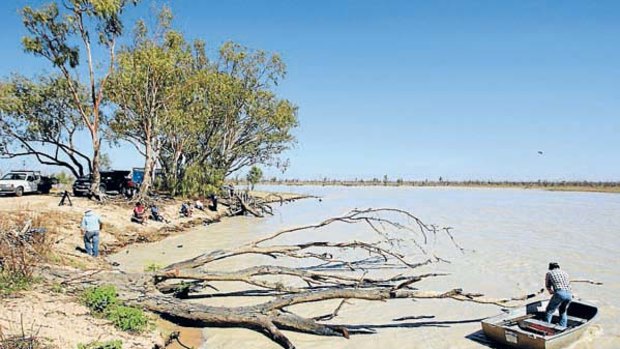
Bird's-eye view ... Menindee Lake in the soaked interior of NSW.Credit: Wolter Peeters
Lee Atkinson manages to stay one step ahead of the floodwaters on a road trip through outback NSW.
The people who live in Lightning Ridge never let an opportunity pass them by. The country has been in drought for too long to remember but the faraway Queensland rains have transformed the normally parched plains around the opal-mining town into a vast inland sea; everyone, it seems, on this hot, sunny afternoon, has downed their tools, picked up a fishing rod or tyre tube and headed out to the slowly submerging highway to fish, float or paddle. They've been waiting for this flood for a long time and they are not going to waste a minute of it, so they turn a roadblock into a street party.
The NSW outback has never looked better. The red dust has been replaced by a seemingly limitless sea of green, the paddocks full of thigh-high grass and great flocks of birds fill the sky, wheeling above newly formed billabongs.
It's not something you see every day and for someone who grew up on the western plains in a decade when it hardly ever rained, it was an opportunity too good to miss. So, late last month, we jumped on a plane to Dubbo, hired a car and hit the road, not in a blaze of dust, like you normally would out here, but in a flurry of grasshoppers, which have hatched out of the ground at the first hint of the good times ahead. By the time we reached Gulargambone, with its forest of silver corrugated-iron galahs and fabulous volunteer-run 2828 cafe and gallery (best coffee west of Leichhardt) two hours down the road, the front of our vehicle was plastered with grasshopper guts. It took another three hours or so to reach Lightning Ridge, where the waters were steadily creeping at a snail's pace towards the town. There's no river in (or near) dry and dusty Lightning Ridge, which was baking under a cloudless blue sky, so it was hard to believe the town was preparing for the big wet to come with dozens of SES folk in town, but the nature of the flood plains that fill up when it rains in Queensland mean that when the waters come, they come slowly, with plenty of time to prepare. It wasn't until we headed up the road towards Goodooga that we saw the water everyone's been talking about. It was slow and shallow and sluggish, fanning out towards the horizon in all directions. Pelicans seemed to have appeared from nowhere, idly perched on fence posts as if waiting for the splashing locals to go home and leave them to their fish.
With the floodwaters not expected to reach the Darling River for another week or so, we headed to Brewarrina, the last town on the Barwon before the river changes its name to the Darling.
We'd hoped to get a look at the famous Aboriginal fish traps, believed to be more than 40,000 years old and one of the oldest human-made structures on earth. Of course, the stone traps were well and truly submerged, so we consoled ourselves with an afternoon tea made by the ladies of the CWA (Country Women's Association). Believe me, you've never had a proper scone until you've had one baked by these master chefs of the bush.
The river was higher than normal in Bourke, too, 100 kilometres down the track. The Darling was once lauded as a second Mississippi and Bourke was a big river port back in the 1870s, when more than 100 paddle-steamers, laden with bales of wool and other goods, rode the river all the way to the sea in South Australia.
There's just one on this section of the river these days, the PV Jandra, which usually takes tourists on a river cruise, but it's out of action until April 21 because of the floods, so we spent the day instead learning about how the Queensland rains have helped shaped the country through cycles of boom and bust at the new Back O'Bourke museum. We learnt where the phrase Back O'Bourke comes from (a poem by Scotsman Will Ogilvie), looked at the town and outback though the eyes and words of Breaker Morant and Henry Lawson, who reckoned that "If you know Bourke, you know Australia" and lost ourselves in stories and legends.
At first, the $20 entry fee seemed steep but it's the type of place where you can spend all day.
But it's the astonishing landscape that lingers most in the memory from this road trip. The red, dusty plains of outback NSW are seldom this green. Go now before the land dries up again.
The writer was guest of Outback NSW Tourism.
TRIP NOTES
GETTING THERE
Lightning Ridge is about 750 kilometres north-west of Sydney, this drive loop from Dubbo is about 1030 kilometres. Qantas (qantas.com.au) and Rex (rex.com.au) have daily flights between Sydney and Dubbo.
WHERE TO STAY
Bourke Riverside Motel has beautiful heritage suites. Phone (02) 6872 2539, see bourkeriversidemotel.com.
Lightning Ridge Hotel Motel has basic motel-style units and a caravan park. Phone (02) 6829 0304, see ridgehotelmotel.com.au.
FURTHER INFORMATION
Roads are open around Lightning Ridge. Locals at Bourke are expecting things to return to a much greener normal by middle of this week, although some minor back roads will still be closed. The SES expects some areas of the state's north-west to be affected by flooding well into next month.
For the latest flood information and road closures check with the local shire councils or phone the RTA on 131 700. The SES (www.ses.nsw.gov.au) has details on flood-affected areas.
See visitoutbacknsw.com.
Sign up for the Traveller Deals newsletter
Get exclusive travel deals delivered straight to your inbox. Sign up now.